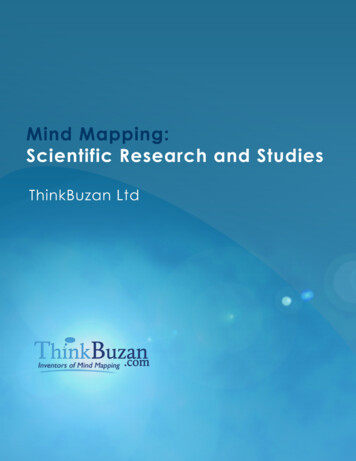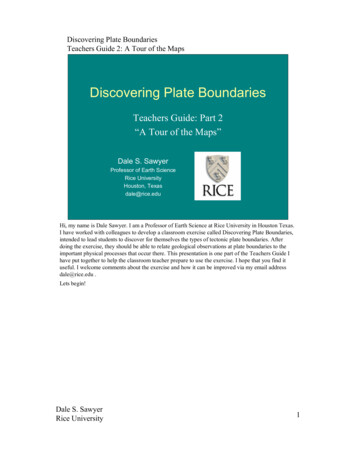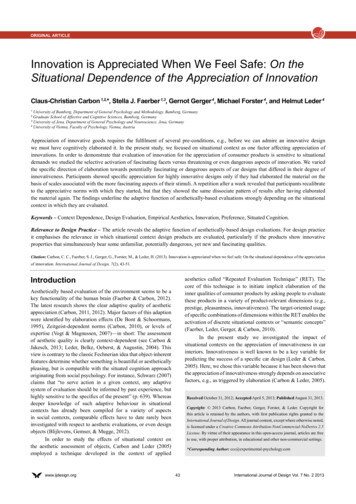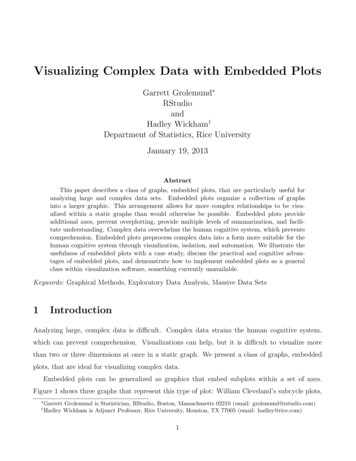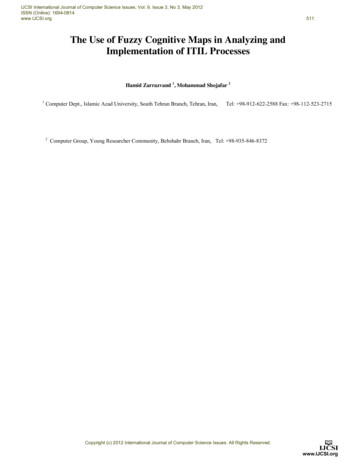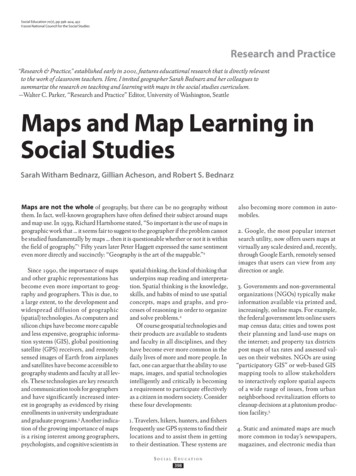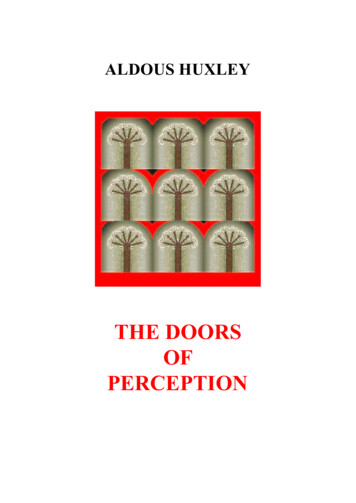
Transcription
ALDOUS HUXLEYTHE DOORSOFPERCEPTION
2It was in 1886 that the German pharmacologist, Louis Lewin, published the first systematic study ofthe cactus, to which his own name was subsequently given. Anhalonium lewinii was new to science.To primitive religion and the Indians of Mexico and the American Southwest it was a friend ofimmemorially long standing. Indeed, it was much more than a friend. In the words of one of the earlySpanish visitors to the New World, "they eat a root which they call peyote, and which they venerate asthough it were a deity."Why they should have venerated it as a deity became apparent when such eminent psychologists asJaensch, Havelock Ellis and Weir Mitchell began their experiments with mescalin, the active principle ofpeyote. True, they stopped short at a point well this side of idolatry; but all concurred in assigning tomescalin a position among drugs of unique distinction. Administered in suitable doses, it changes thequality of consciousness more profoundly and yet is less toxic than any other substance in thepharmacologist's repertory.Mescalin research has been going on sporadically ever since the days of Lewin and Havelock Ellis.Chemists have not merely isolated the alkaloid; they have learned how to synthesize it, so that the supplyno longer depends on the sparse and intermittent crop of a desert cactus. Alienists have dosedthemselves with mescalin in the hope thereby of coming to a better, a first-hand, understanding of theirpatients' mental processes. Working unfortunately upon too few subjects within too narrow a range ofcircumstances, psychologists have observed and catalogued some of the drug's more striking effects.Neurologists and physiologists have found out something about the mechanism of its action upon thecentral nervous system. And at least one Professional philosopher has taken mescalin for the light it maythrow on such ancient, unsolved riddles as the place of mind in nature and the relationship between brainand consciousness1.There matters rested until, two or three years ago, a new and perhaps highly significant fact wasobserved2. Actually the fact had been staring everyone in the face for several decades; but nobody, as ithappened, had noticed it until a Young English psychiatrist, at present working in Canada, was struckby the close similarity, in chemical composition, between mescalin and adrenalin. Further research1 See the following papers: "Schizophrenia. A New Approach." By Humphry Osmond and John Smythies. Journal ofMental Science. Vol. XCVIII. April, 1952."On Being Mad." By Humphry Osmond. Saskarchewan Psychiatric Services Journal. Vol. I. No. 2. September.1952. "The Mescalin Phenomena." By John Smythies. The British Journal of the Philosophy of Science. Vol. III.February, 1953. "Schizophrenia: A New Approach." By Abeam Hoffer, Humphry Osmond and John Smythies. journalof Mental Science. Vol. C. No. 418. January, 1954.Numerous other papers on the biochemistry, pharmacology, psychology and neurophysiology of schizophrenia sadthe mescalin phenomena are in preparation2 In his monograph, Menomini Peyolism, published (December 1952) in the Transactions of the AmericanPhilosophical Society, Professor J. S. Slotkin has written that "the habitual use of Peyote does not seem to produceany increased tolerance or dependence. I know many people who have been Peyotists for forty to fifty years. Theamount of Peyote they use depends upon the solemnity of the occasion; in general they do not take any more Peyotenow than they did years ago. Also, there is sometimes an interval of a month or more between rites, and they gowithout Peyote during this period without feeling any craving for it. Personally, even after a series of rites occurringon four successive weekends. I neither increased the amount of Peyote consumed nor felt any continued need for it."It is evidently with good reason that "Peyote has never been legally declared a narcotic, or its use prohibited by thefederal government." However, "during the long history of Indian-white contact, white officials have usually tried tosuppress the use of Peyote, because it has been conceived to violate their own mores. But these at- tempts havealways failed." In a footnote Dr. Slotkin adds that "it is amazing to hear the fantastic stories about the effects ofPeyote and the nature of the ritual, which are told by the white and Catholic Indian officials in the MenominiReservation. None of them have had the slightest first-hand experience with the plant or with the religion, yet somefancy themselves to be authorities and write official reports on the subject."
3revealed that lysergic acid, an extremely potent hallucinogen derived from ergot, has a structuralbiochemical relationship to the others. Then came the discovery that adrenochrome, which is a productof the decomposition of adrenalin, can produce many of the symptoms observed in mescalinintoxication. But adrenochrome probably occurs spontaneously in the human body. In other words,each one of us may be capable of manufacturing a chemical, minute doses of which are known to causeProfound changes in consciousness. Certain of these changes are similar to those which occur in thatmost characteristic plague of the twentieth century, schizophrenia. Is the mental disorder due to achemical disorder? And is the chemical disorder due, in its turn, to psychological distresses affecting theadrenals? It would be rash and premature to affirm it. The most we can say is that some kind of a primafacie case has been made out. Meanwhile the clue is being systematically followed, the sleuths biochemists , psychiatrists, psychologists - are on the trail.By a series of, for me, extremely fortunate circumstances I found myself, in the spring of 1953,squarely athwart that trail. One of the sleuths had come on business to California. In spite of seventyyears of mescalin research, the psychological material at his disposal was still absurdly inadequate, andhe was anxious to add to it. I was on the spot and willing, indeed eager, to be a guinea pig. Thus it cameabout that, one bright May morning, I swallowed four-tenths of a gram of mescalin dissolved in half aglass of water and sat down to wait for the results.We live together, we act on, and react to, one another; but always and in all circumstances we areby ourselves. The martyrs go hand in hand into the arena; they are crucified alone. Embraced, the loversdesperately try to fuse their insulated ecstasies into a single self-transcendence; in vain. By its verynature every embodied spirit is doomed to suffer and enjoy in solitude. Sensations, feelings, insights,fancies - all these are private and, except through symbols and at second hand, incommunicable. Wecan pool information about experiences, but never the experiences themselves. From family to nation,every human group is a society of island universes. Most island universes are sufficiently like one anotherto Permit of inferential understanding or even of mutual empathy or "feeling into." Thus, remembering ourown bereavements and humiliations, we can condole with others in analogous circumstances, can putourselves (always, of course, in a slightly Pickwickian sense) in their places. But in certain casescommunication between universes is incomplete or even nonexistent. The mind is its own place, and thePlaces inhabited by the insane and the exceptionally gifted are so different from the places whereordinary men and women live, that there is little or no common ground of memory to serve as a basis forunderstanding or fellow feeling. Words are uttered, but fail to enlighten. The things and events to whichthe symbols refer belong to mutually exclusive realms of experience.To see ourselves as others see us is a most salutary gift. Hardly less important is the capacity to seeothers as they see themselves. But what if these others belong to a different species and inhabit aradically alien universe? For example, how can the sane get to know what it actually feels like to bemad? Or, short of being born again as a visionary, a medium, or a musical genius, how can we ever visitthe worlds which, to Blake, to Swedenborg, to Johann Sebastian Bach, were home? And how can aman at the extreme limits of ectomorphy and cerebrotonia ever put himself in the place of one at thelimits of endomorphy and viscerotonia, or, except within certain circumscribed areas, share the feelingsof one who stands at the limits of mesomorphy and somatotonia? To the unmitigated behaviorist suchquestions, I suppose, are meaningless. But for those who theoretically believe what in practice theyknow to be true - namely, that there is an inside to experience as well as an outside - the problemsposed are real problems, all the more grave for being, some completely insoluble, some soluble only inexceptional circumstances and by methods not available to everyone. Thus, it seems virtually certain thatI shall never know what it feels like to be Sir John Falstaff or Joe Louis. On the other hand, it had
4always seemed to me possible that, through hypnosis, for example, or autohypnosis, by means ofsystematic meditation, or else by taking the appropriate drug, I might so change my ordinary mode ofconsciousness as to be able to know, from the inside, what the visionary, the medium, even the mysticwere talking about.From what I had read of the mescalin experience I was convinced in advance that the drug wouldadmit me, at least for a few hours, into the kind of inner world described by Blake and AE. But what Ihad expected did not happen. I had expected to lie with my eyes shut, looking at visions of manycolored geometries, of animated architectures, rich with gems and fabulously lovely, of landscapes withheroic figures, of symbolic dramas trembling perpetually on the verge of the ultimate revelation. But Ihad not reckoned, it was evident, with the idiosyncrasies of my mental make-up, the facts of mytemperament, training and habits.I am and, for as long as I can remember, I have always been a poor visualizer. Words, even thepregnant words of poets, do not evoke pictures in my mind. No hypnagogic visions greet me on theverge of sleep. When I recall something, the memory does not present itself to me as a vividly seenevent or object. By an effort of the will, I can evoke a not very vivid image of what happened yesterdayafternoon, of how the Lungarno used to look before the bridges were destroyed, of the BayswaterRoad when the only buses were green and tiny and drawn by aged horses at three and a half miles anhour. But such images have little substance and absolutely no autonomous life of their own. They standto real, perceived objects in the same relation as Homer's ghosts stood to the men of flesh and blood,who came to visit them in the shades. Only when I have a high temperature do my mental images cometo independent life. To those in whom the faculty of visualization is strong my inner world must seemcuriously drab, limited and uninteresting. This was the world - a poor thing but my own - which Iexpected to see transformed into something completely unlike itself.The change which actually took place in that world was in no sense revolutionary. Half an hour afterswallowing the drug I became aware of a slow dance of golden lights. A little later there weresumptuous red surfaces swelling and expanding from bright nodes of energy that vibrated with acontinuously changing, patterned life. At another time the closing of my eyes revealed a complex of graystructures, within which pale bluish spheres kept emerging into intense solidity and, having emerged,would slide noiselessly upwards, out of sight. But at no time were there faces or forms of men oranimals. I saw no landscapes, no enormous spaces, no magical growth and metamorphosis of buildings,nothing remotely like a drama or a parable. The other world to which mescalin admitted me was not theworld of visions; it existed out there, in what I could see with my eyes open. The great change was inthe realm of objective fact. What had happened to my subjective universe was relatively unimportant.I took my pill at eleven. An hour and a half later, I was sitting in my study, looking intently at a smallglass vase. The vase contained only three flowers-a full-blown Belie of Portugal rose, shell pink with ahint at every petal's base of a hotter, flamier hue; a large magenta and cream-colored carnation; and,pale purple at the end of its broken stalk, the bold heraldic blossom of an iris. Fortuitous andprovisional, the little nosegay broke all the rules of traditional good taste. At breakfast that morning Ihad been struck by the lively dissonance of its colors. But that was no longer the point. I was notlooking now at an unusual flower arrangement. I was seeing what Adam had seen on the morning of hiscreation-the miracle, moment by moment, of naked existence."Is it agreeable?" somebody asked. (During this Part of the experiment, all conversations wererecorded on a dictating machine, and it has been possible for me to refresh my memory of what wassaid.)"Neither agreeable nor disagreeable," I answered. "it just is."
5Istigkeit - wasn't that the word Meister Eckhart liked to use? "Is-ness." The Being of Platonicphilosophy - except that Plate seems to have made the enormous, the grotesque mistake of separatingBeing from becoming and identifying it with the mathematical abstraction of the Idea. He could never,poor fellow, have seen a bunch of flowers shining with their own inner light and all but quivering underthe pressure of the significance with which they were charged; could never have perceived that whatrose and iris and carnation so intensely signified was nothing more, and nothing less, than what theywere - a transience that was yet eternal life, a perpetual perishing that was at the same time pure Being,a bundle of minute, unique particulars in which, by some unspeakable and yet self-evident paradox, wasto be seen the divine source of all existence.I continued to look at the flowers, and in their living light I seemed to detect the qualitativeequivalent of breathing -but of a breathing without returns to a starting point, with no recurrent ebbs butonly a repeated flow from beauty to heightened beauty, from deeper to ever deeper meaning. Wordslike "grace" and "transfiguration" came to my mind, and this, of course, was what, among other things,they stood for. My eyes traveled from the rose to the carnation, and from that feathery incandescence tothe smooth scrolls of sentient amethyst which were the iris. The Beatific Vision, Sat Chit Ananda, BeingAwareness-Bliss-for the first time I understood, not on the verbal level, not by inchoate hints or at adistance, but precisely and completely what those prodigious syllables referred to. And then Iremembered a passage I had read in one of Suzuki's essays. "What is the Dharma-Body of theBuddha?" ('"the Dharma-Body of the Buddha" is another way of saying Mind, Suchness, the Void, theGodhead.) The question is asked in a Zen monastery by an earnest and bewildered novice. And withthe prompt irrelevance of one of the Marx Brothers, the Master answers, "The hedge at the bottom ofthe garden." "And the man who realizes this truth," the novice dubiously inquires, '"what, may I ask, ishe?" Groucho gives him a whack over the shoulders with his staff and answers, "A golden-haired lion."It had been, when I read it, only a vaguely pregnant piece of nonsense. Now it was all as clear asday, as evident as Euclid. Of course the Dharma-Body of the Buddha was the hedge at the bottom ofthe garden. At the same time, and no less obviously, it was these flowers, it was anything that I - orrather the blessed Not-I, released for a moment from my throttling embrace - cared to look at. Thebooks, for example, with which my study walls were lined. Like the flowers, they glowed, when Ilooked at them, with brighter colors, a profounder significance. Red books, like rubies; emerald books;books bound in white jade; books of agate; of aquamarine, of yellow topaz; lapis lazuli books whosecolor was so intense, so intrinsically meaningful, that they seemed to be on the point of leaving theshelves to thrust themselves more insistently on my attention."What about spatial relationships?" the investigator inquired, as I was looking at the books.It was difficult to answer. True, the perspective looked rather odd, and the walls of the room nolonger seemed to meet in right angles. But these were not the really important facts. The really importantfacts were that spatial relationships had ceased to matter very much and that my mind was perceivingthe world in terms of other than spatial categories. At ordinary times the eye concerns itself with suchproblems as Where? - How far? How situated in relation to what? In the mescalin experience theimplied questions to which the eye responds are of another order. Place and distance cease to be ofmuch interest. The mind does its Perceiving in terms of intensity of existence, profundity of significance,relationships within a pattern. I saw the books, but was not at all concerned with their positions inspace. What I noticed, what impressed itself upon my mind was the fact that all of them glowed withliving light and that in some the glory was more manifest than in others. In this context position and thethree dimensions were beside the point. Not, of course, that the category of space had been abolished.When I got up and walked about, I could do so quite normally, without misjudging the whereabouts of
6objects. Space was still there; but it had lost its predominance. The mind was primarily concerned, notwith measures and locations, but with being and meaning.And along with indifference to space there went an even more complete indifference to time. "Thereseems to be plenty of it," was all I would answer, when the investigator asked me to say what I feltabout time. Plenty of it, but exactly how much was entirely irrelevant. I could, of course, have looked atmy watch; but my watch, I knew, was in another universe. My actual experience had been, was still, ofan indefinite duration or alternatively of a perpetual present made up of one continually changingapocalypse.From the books the investigator directed my attention to the furniture. A small typing table stood inthe center of the room; beyond it, from my point of view, was a wicker chair and beyond that a desk.The three pieces formed an intricate pattern of horizontals, uprights and diagonals - a pattern all themore interesting for not being interpreted in terms of spatial relationships. Table, chair and desk cametogether in a composition that was like something by Braque or Juan Gris, a still life recognizably relatedto the objective world, but rendered without depth, without any attempt at photographic realism. I waslooking at my furniture, not as the utilitarian who has to sit on chairs, to write at desks and tables, andnot as the cameraman or scientific recorder, but as the pure aesthete whose concern is only with formsand their relationships within the field of vision or the picture space. But as I looked, this purelyaesthetic, Cubist's-eye view gave place to what I can only describe as the sacramental vision of reality. Iwas back where I had been when I was looking at the flowers-back in a world where everything shonewith the Inner Light, and was infinite in its significance. The legs, for example, of that chair - howmiraculous their tubularity, how supernatural their polished smoothness! I spent several minutes - or wasit several centuries? - not merely gazing at those bamboo legs, but actually being them - or rather beingmyself in them; or, to be still more accurate (for "I" was not involved in the case, nor in a certain sensewere "they") being my Not-self in the Not-self which was the chair.Reflecting on my experience, I find myself agreeing with the eminent Cambridge philosopher, Dr. C.D. Broad, "that we should do well to consider much more seriously than we have hitherto been inclinedto do the type of theory which Bergson put forward in connection with memory and sense perception.The suggestion is that the function of the brain and nervous system and sense organs is in the maineliminative and not productive. Each person is at each moment capable of remembering all that has everhappened to him and of perceiving everything that is happening everywhere in the universe. The functionof the brain and nervous system is to protect us from being overwhelmed and confused by this mass oflargely useless and irrelevant knowledge, by shutting out most of what we should otherwise perceive orremember at any moment, and leaving only that very small and special selection which is likely to bepractically useful." According to such a theory, each one of us is potentially Mind at Large. But in so faras we are animals, our business is at all costs to survive. To make biological survival possible, Mind atLarge has to be funneled through the reducing valve of the brain and nervous system. What comes outat the other end is a measly trickle of the kind of consciousness which will help us to stay alive on thesurface of this Particular planet. To formulate and express the contents of this reduced awareness, manhas invented and endlessly elaborated those symbol-systems and implicit philosophies which we calllanguages. Every individual is at once the beneficiary and the victim of the linguistic tradition into whichhe has been born - the beneficiary inasmuch as language gives access to the accumulated records ofother people's experience, the victim in so far as it confirms him in the belief that reduced awareness isthe only awareness and as it bedevils his sense of reality, so that he is all too apt to take his concepts fordata, his words for actual things. That which, in the language of religion, is called "this world" is theuniverse of reduced awareness, expressed, and, as it were, petrified by language. The various "other
7worlds," with which human beings erratically make contact are so many elements in the totality of theawareness belonging to Mind at Large. Most people, most of the time, know only what comes throughthe reducing valve and is consecrated as genuinely real by the local language. Certain persons, however,seem to be born with a kind of by-pass that circumvents the reducing valve. In others temporary bypasses may be acquired either spontaneously, or as the result of deliberate "spiritual exercises," orthrough hypnosis, or by means of drugs. Through these permanent or temporary by-passes there flows,not indeed the perception "of everything that is happening everywhere in the universe" (for the by-passdoes not abolish the reducing valve, which still excludes the total content of Mind at Large), butsomething more than, and above ah something different from, the carefully selected utilitarian materialwhich our narrowed, individual minds regard as a complete, or at least sufficient, picture of reality.The brain is provided with a number of enzyme systems which serve to co-ordinate its workings.Some of these enzymes regulate the supply of glucose to the brain cells. Mescalin inhibits the productionof these enzymes and thus lowers the amount of glucose available to an organ that is in constant need ofsugar. When mescalin reduces the brain's normal ration of sugar what happens? Too few cases havebeen observed, and therefore a comprehensive answer cannot yet be given. But what happens to themajority of the few who have taken mescalin under supervision can be summarized as follows.The ability to remember and to "think straight" is little if at all reduced. (Listening to the recordingsof my conversation under the influence of the drug, I cannot discover that I was then any stupider than Iam at ordinary times.)Visual impressions are greatly intensified and the eye recovers some of the perceptual innocence ofchildhood, when the sensum was not immediately and automatically subordinated to the concept.Interest in space is diminished and interest in time falls almost to zero.Though the intellect remains unimpaired and though perception is enormously improved, the willsuffers a profound change for the worse. The mescalin taker sees no reason for doing anything inparticular and finds most of the causes for which, at ordinary times, he was prepared to act and suffer,profoundly uninteresting. He can't be bothered with them, for the good reason that he has better thingsto think about.These better things may be experienced (as I experienced them) "out there," or "in here," or in bothworlds, the inner and the outer, simultaneously or successively. That they are better seems to be selfevident to all mescalin takers who come to the drug with a sound liver and an untroubled mind.These effects of mescalin are the sort of effects you could expect to follow the administration of adrug having the power to impair the efficiency of the cerebral reducing valve. When the brain runs out ofsugar, the undernourished ego grows weak, can't be bothered to undertake the necessary chores, andloses all interest in those spatial and temporal relationships which mean so much to an organism bent ongetting on in the world. As Mind at Large seeps past the no longer watertight valve, all kinds ofbiologically useless things start to happen. In some cases there may be extra-sensory perceptions. Otherpersons discover a world of visionary beauty. To others again is revealed the glory, the infinite value andmeaningfulness of naked existence, of the given, unconceptualized event. In the final stage of egolessnessthere is an "obscure knowledge" that All is in all - that All is actually each. This is as near, I take it, as afinite mind can ever come to "perceiving everything that is happening everywhere in the universe."In this context, how significant is the enormous heightening, under mescalin, of the perception ofcolor! For certain animals it is biologically very important to be able to distinguish certain hues. Butbeyond the limits of their utilitarian spectrum, most creatures are completely color blind. Bees, forexample, spend most of their time "deflowering the fresh virgins of the spring"; but, as Von Frisch hasshown, they can recognize only a very few colors. Man's highly developed color sense is a biological
8luxury - inestimably precious to him as an intellectual and spiritual being, but unnecessary to his survivalas an animal. To judge by the adjectives which Homer puts into their mouths, the heroes of the TrojanWar hardly excelled the bees in their capacity to distinguish colors. In this respect, at least, mankind'sadvance has been prodigious.Mescalin raises all colors to a higher power and makes the percipient aware of innumerable fineshades of difference, to which, at ordinary times, he is completely blind. It would seem that, for Mind atLarge, the so-called secondary characters of things are primary. Unlike Locke, it evidently feels thatcolors are more important, better worth attending to, than masses, positions and dimensions. Likemescalin takers, many mystics perceive supernaturally brilliant colors, not only with the inward eye, buteven in the objective world around them. Similar reports are made by psychics and sensitives. There arecertain mediums to whom the mescalin taker's brief revelation is a matter, during long periods, of dailyand hourly experience.From this long but indispensable excursion into the realm of theory, we may now return to themiraculous facts - four bamboo chair legs in the middle of a room. Like Wordsworth's daffodils, theybrought all manner of wealth - the gift, beyond price, of a new direct insight into the very Nature ofThings, together with a more modest treasure of understanding in the field, especially, of the arts. A roseis a rose is a rose. But these chair legs were chair legs were St. Michael and all angels. Four or fivehours after the event, when the effects of a cerebral sugar shortage were wearing off, I was taken for alittle tour of the city, which included a visit, towards sundown, to what is modestly claimed to be theWorld's Biggest Drug Store. At the back of the W.B.D.S., among the toys, the greeting cards and thecomics, stood a row, surprisingly enough, of art books. I picked up the first volume that came to hand.It was on Van Gogh, and the picture at which the book opened was "The Chair" - that astoundingportrait of a Ding an Sich, which the mad painter saw, with a kind of adoring terror, and tried to renderon his canvas. But it was a task to which the power even of genius proved wholly inadequate. The chairVan Gogh had seen was obviously the same in essence as the chair I had seen. But, thoughincomparably more real than the chairs of ordinary perception, the chair in his picture remained no morethan an unusually expressive symbol of the fact. The fact had been manifested Suchness; this was onlyan emblem. Such emblems are sources of true knowledge about the Nature of Things, and this trueknowledge may serve to prepare the mind which accepts it for immediate insights on its own account.But that is all. However expressive, symbols can never be the things they stand for.It would be interesting, in this context, to make a study of the works of art available to the greatknowers of Suchness. What sort of pictures did Eckhart look at? What sculptures and paintings playeda part in the religious experience of St. John of the Cross, of Hakuin, of Hui-neng, of William Law? Thequestions are beyond my power to answer; but I strongly suspect that most of the great knowers ofSuchness paid very little attention to art - some refusing to have anything to do with it at all, others beingcontent with what a critical eye would regard as second-rate, or even, tenth-rate, works. (To a personwhose transfigured and transfiguring mind can see the All in every this, the first-rateness or tenthrateness of even a religious painting will be
to real, perceived objects in the same relation as Homer's ghosts stood to the men of flesh and blood, who came to visit them in the shades. Only when I have a high temperature do my mental images come to independent life. To those in whom the faculty of visualization is strong my inner w

